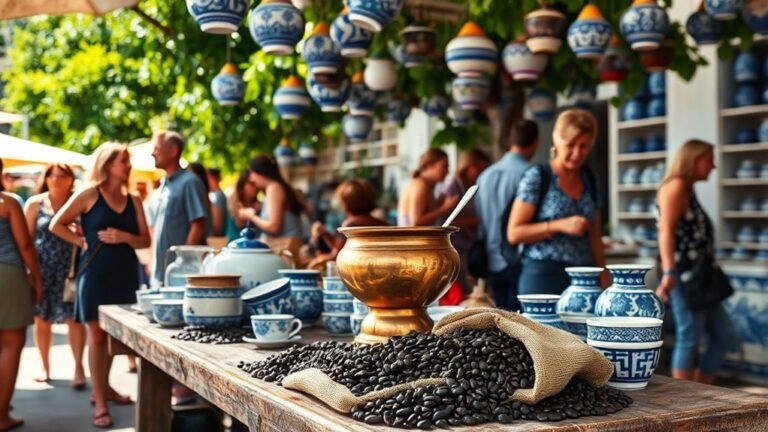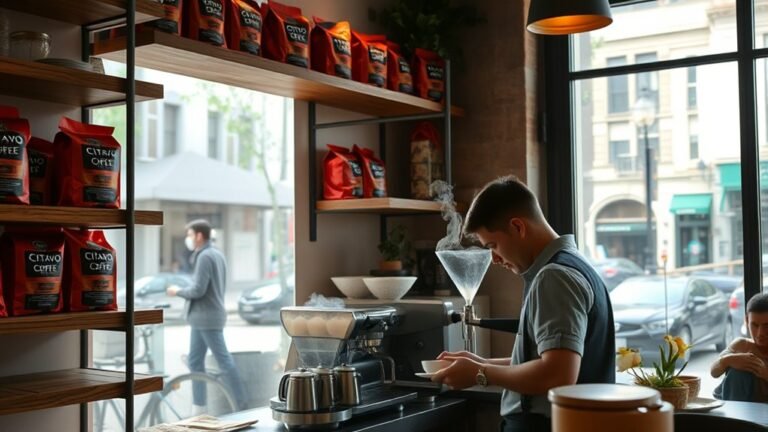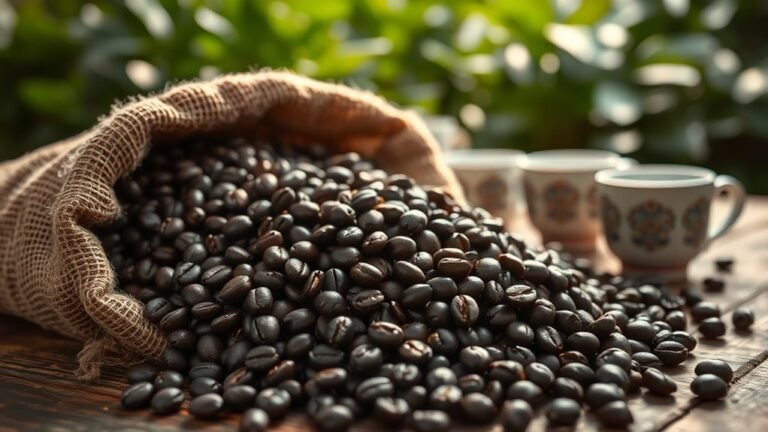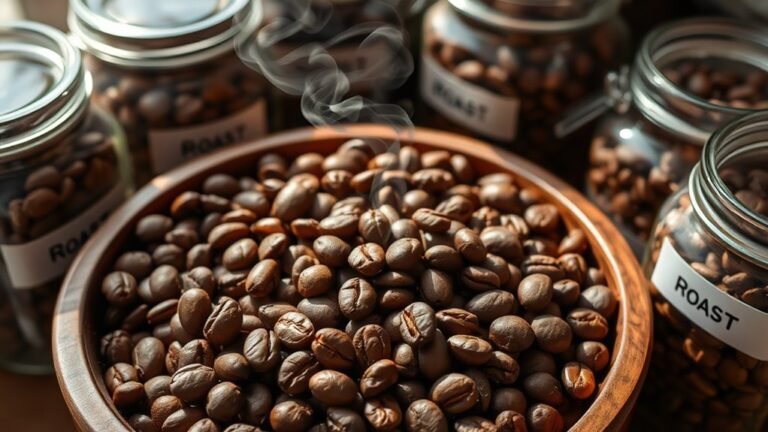The Art of Coffee Roasting: From Green Beans to Brewed Cup
To master coffee roasting, start by selecting green beans with unique traits like origin and moisture content, which influence flavor. Understand how roasting triggers complex chemical reactions—Maillard and caramelization—that craft aroma, acidity, and body. Choose roasting equipment carefully; drum roasters deepen flavors, while hot air roasters keep them bright. Adjust roast levels to balance acidity and strength. Finally, precision brewing with proper grind size and temperature releases your beans’ fullest taste. Explore further to perfect each essential step in this transformative journey.
Understanding Green Coffee Beans
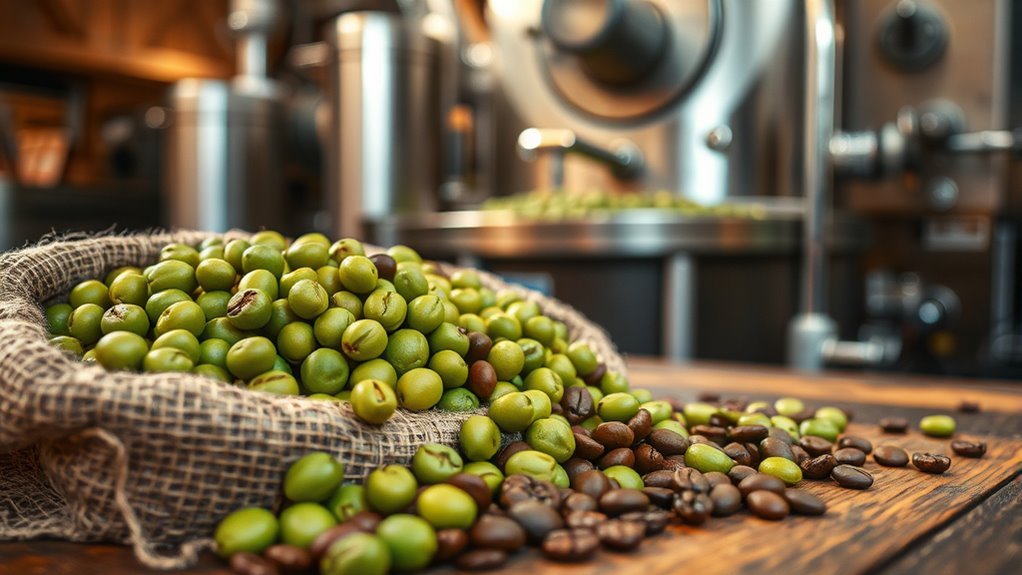
Green coffee beans are the foundation of every great roast, and understanding their characteristics is essential if you want to master the roasting process. You’ll find that green bean origins greatly influence flavor profiles—beans from Ethiopia offer floral notes, while those from Colombia lean toward nuttier undertones. Recognizing coffee bean varieties is equally critical; Arabica beans, prized for their complexity, differ markedly from the robust, earthy flavors of Robusta. Each variety demands a tailored roasting approach to reveal its unique potential. By studying these raw beans’ moisture content, density, and size, you gain control over how heat transforms them. Embracing this knowledge grants you the freedom to craft roasts that reflect your vision, not just follow trends—turning raw potential into an artful brew.
The Science Behind Roasting
Although roasting might seem like a simple heating process, it’s actually a complex chemical transformation that releases the flavors locked inside each bean. As you roast, heat transfer drives a series of chemical reactions that develop aroma, acidity, and body. You’re not just cooking beans — you’re orchestrating a delicate balance.
Roasting transforms beans through complex chemistry, unlocking aroma, acidity, and body—a precise balance, not just heat.
Here’s what happens inside the roaster:
- Moisture evaporation: Water escapes, preparing the bean for transformation.
- Maillard reaction: Sugars and amino acids create rich browns and complex flavors.
- Caramelization: Sugars break down, adding sweetness and depth.
- Cracking: Beans physically crack as gases expand, signaling critical flavor milestones.
Embracing this scientific dance lets you craft coffee that embodies freedom — bold, nuanced, and uniquely yours.
Roasting Techniques and Equipment
When you choose between a drum roaster and a hot air roaster, you’re selecting not just equipment but a distinct flavor development process driven by heat transfer methods. Drum roasters envelop beans in a rotating drum with direct contact heat, yielding rich, uniform profiles, while hot air roasters use convection to create brighter, cleaner notes. Embracing small batch roasting amplifies your control over these variables, allowing precise adjustments that reveal the coffee’s fullest potential.
Drum Roaster vs. Hot Air
How do you decide between a drum roaster and a hot air roaster for your coffee? It comes down to drum efficiency versus air consistency. Drum roasters use a rotating drum to tumble beans, ensuring even heat distribution and a rich, deep roast. Hot air roasters rely on consistent airflow to roast beans quickly and uniformly.
Imagine:
- Beans tumbling in a heated metal drum, absorbing radiant heat.
- Hot air rushing through beans, roasting with convection precision.
- You controlling drum speed to tweak roast depth.
- Adjusting airflow to preserve delicate bean flavors.
Choosing between them means embracing either the tactile control and robustness of drum roasting or the swift, clean roast profile hot air delivers. Your freedom lies in mastering either method’s unique rhythm.
Small Batch Roasting Benefits
Because small batch roasting allows you to precisely control every variable, it’s the ideal approach for achieving nuanced flavor profiles and consistency. You gain a freshness advantage that preserves the coffee’s vibrant aromatics, revealing flavor diversity impossible with mass roasting. This artisanal quality reflects sustainable sourcing and community engagement, connecting you directly to the beans’ origin. Small batch roasting also creates experimentation opportunities—letting you personalize roasting curves to highlight unique bean characteristics.
| Benefit | Description |
|---|---|
| Flavor Diversity | Tailor roast profiles for complex tastes |
| Artisanal Quality | Emphasize craft through detailed control |
| Freshness Advantage | Roast close to brew time for peak flavor |
| Personalized Roasting | Adjust parameters for unique beans |
With freedom to refine your craft, small batch roasting elevates coffee from commodity to art.
Flavor Development During Roasting
When you roast coffee, the Maillard reaction plays an essential role in transforming amino acids and sugars into complex flavor compounds that define your cup’s character. You’ll notice that varying the roast level dramatically shifts these flavors, from bright and acidic in light roasts to rich and bittersweet in dark ones. Understanding how heat and time manipulate these chemical processes lets you craft the precise flavor profile you want.
Maillard Reaction Impact
Although the Maillard reaction occurs alongside caramelization and other chemical changes during roasting, it plays a uniquely essential role in shaping coffee’s complex flavor profile. As you control the roast, this reaction between amino acids and reducing sugars sparks an explosion of flavor complexity that defines your brew’s character.
Here’s what happens during the Maillard reaction:
- Proteins and sugars recombine, creating hundreds of new flavor compounds.
- Nutty, toasty, and savory notes emerge, deepening your coffee’s aroma.
- The reaction intensifies as temperature rises, demanding precise control.
- Subtle shifts in this process reveal unique flavors, allowing you to craft a signature roast.
Mastering the Maillard reaction means harnessing its transformative power to release your coffee’s fullest potential.
Roast Level Influence
Three primary roast levels—light, medium, and dark—each reveal distinct stages of chemical transformation that define your coffee’s ultimate flavor profile. As you control the roast profile, you release unique flavor notes, shaping acidity levels, body texture, and aroma development. Light roast preserves origin characteristics and caffeine content, offering bright acidity and complex sensory experience. Dark roast intensifies roasting consistency, emphasizing boldness and reduced acidity, deepening the body texture. Medium roast balances these elements harmoniously.
| Roast Level | Flavor Notes | Sensory Impact |
|---|---|---|
| Light Roast | Floral, Fruity | Bright acidity, crisp |
| Medium Roast | Balanced, Nutty | Smooth body, rich aroma |
| Dark Roast | Smoky, Bitter-Sweet | Bold, fuller body |
Mastering these transforms your coffee freedom.
Common Roast Levels and Their Characteristics
Since roasting profoundly transforms the chemical and physical properties of coffee beans, understanding the common roast levels is essential to mastering flavor profiles. You’ll want to control development time and ideal temperature carefully to reveal distinct characteristics:
Mastering roast levels and controlling development time unlocks coffee’s unique flavors and aromas.
- Light Roast – Preserves high acidity levels, vibrant flavor notes, and a delicate aroma profile; shorter development time and lower temperatures highlight origin nuances.
- Medium Roast – Balances acidity and body strength, with richer flavor notes and a sweeter aroma; development time extends to enhance complexity.
- Medium-Dark Roast – Deepens body strength and caramelizes sugars, reducing acidity; aroma becomes more robust and chocolatey.
- Dark Roast – Emphasizes bold, smoky flavors with diminished acidity; long development time and high temperatures create a pronounced, intense profile.
Choose based on your taste preferences to release the full freedom roasting offers.
From Roasted Beans to Brewing Excellence

Once your beans have reached their ideal roast level, the journey to brewing excellence truly begins, demanding precise control over grind size, water temperature, and extraction time. To reveal each coffee origin’s unique profile, you’ll tailor grind size to your chosen brew methods—coarse for French press, fine for espresso—ensuring peak extraction. Water temperature, typically between 195°F and 205°F, must be consistent to dissolve flavorful compounds without scorching delicate notes. Extraction time hinges on balancing these factors; too short yields underdeveloped flavors, too long extracts bitterness. Freedom in brewing means mastering these variables, adapting to the inherent qualities of your roasted beans. By understanding how your roast interacts with brew methods and coffee origins, you’ll craft a cup that honors the bean’s journey from green to perfectly brewed.
Frequently Asked Questions
How Should Green Coffee Beans Be Stored Before Roasting?
You should store green coffee beans in a cool, dark place with stable temperatures to maintain their quality. Ideal storage involves airtight containers that protect beans from oxygen, light, and humidity. Moisture control is essential—beans must stay dry to prevent mold and spoilage. By managing these factors meticulously, you preserve the beans’ freshness and flavor potential, giving you the freedom to roast them perfectly whenever you’re ready.
What Are the Environmental Impacts of Coffee Roasting?
When it comes to coffee roasting, you need to remember it’s not all sunshine and rainbows. Roasting consumes significant energy, increasing your carbon footprint and contributing to air pollution. To reduce this, you can focus on sustainable sourcing and energy-efficient equipment. By choosing greener methods, you’re not just brewing better coffee—you’re safeguarding the planet and embracing the freedom that comes with responsible choices. It’s about balancing passion with environmental care.
Can You Roast Coffee Beans at Home Without Special Equipment?
You absolutely can roast coffee beans at home using DIY methods, no special equipment needed. Techniques like pan roasting, using a popcorn popper, or even an oven give you full control over roast levels, revealing fresh flavors. It’s a hands-on process that demands attention and patience but offers incredible freedom to experiment. Mastering home roasting lets you tailor each batch, bringing out nuances commercial roasters might miss—perfect for passionate coffee lovers craving customization.
How Does Altitude Affect Coffee Roasting Outcomes?
Altitude effects can transform your coffee roasting experience—higher elevations mean lower air pressure, causing beans to roast slower and develop complex flavor profiles. You’ll notice brighter acidity and more nuanced aromas compared to roasting at sea level, where heat transfers faster, leading to bolder, sometimes harsher notes. Understanding these altitude effects empowers you to tweak roasting times and temperatures precisely, revealing the full potential of your beans and truly expressing your roasting freedom.
What Safety Precautions Are Needed During the Roasting Process?
When roasting coffee, you’ve got to respect fire hazards—roasters get insanely hot, and beans release flammable oils. Always keep a fire extinguisher nearby and guarantee proper ventilation to prevent smoke buildup. Wear personal protection like heat-resistant gloves and safety goggles; you’re working with intense heat and hot surfaces. Staying alert and prepared lets you embrace the freedom of crafting perfect roasts without risking burns or fires. Safety fuels your passion and creativity.


